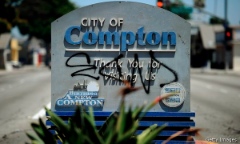Think Motown is the only major U.S. city in a boatload of financial trouble? Think again.
Detroit’s bankruptcy filing sent shivers down the spine of municipal bondholders, government employees, and big-city urban residents all over the country.
That’s because many of the 61 largest U.S. cities are plagued with the same kinds of retirement legacy costs that sent Detroit into Chapter 9 bankruptcy this summer.
These cities have amassed $118 billion in unfunded healthcare liabilities. These are legal promises to pay healthcare benefits to municipal workers beyond the employee contributions to finance those funds. This is a giant fiscal sink hole — and because of defined benefit plans, the hole keeps getting deeper.
Detroit may be the largest city in American history to go bankrupt, but it is not alone. The city raced to the financial insolvency finish line before anyone else in its class.
Keep an eye on “too big to fail” cities like Chicago, Philadelphia, and New York.
According to an analysis by the Manhattan Institute, several Chicago pension funds are in worse financial shape than the worker pensions in Detroit. One is only 25 percent funded, and where the other 75 percent of the money will come from is anyone’s guess. And there are about a dozen major California cities having systemic problems paying their bills.
Here is my worry list, based on bond ratings and other data, of the top 20 cities to watch for financial troubles in the wake of the Detroit story:
1. Compton, Calif.
Compton has teetered on the brink of bankruptcy after it accrued a general-fund deficit of more than $40 million by borrowing from other funds, depleting what had been a $22 million reserve.
2. East Greenbush, N.Y.
A New York state audit concluded that years of fiscal mismanagement — including questionable employment contracts and illegal payments to town officials — left East Greenbush more than $2 million in debt.
3. Fresno, Calif.
Fresno had the ratings of its lease-revenue bonds downgraded to junk-level by Moody’s, which also downgraded its convention center and pension obligation bonds due to the city’s “exceedingly weak financial position.”
4. Gulf County, Fla.
Fitch Ratings warned that Gulf County’s predominately rural economy is “narrowly focused,” with income levels one-quarter below national averages and economic indicators for the county also comparing unfavorably to national averages.
5. Harrisburg, Pa.
Harrisburg is at least $345 million in debt, thanks largely to municipal bonds it guaranteed in order to finance upgrades to its problematic waste-to-energy trash incinerator.
6. Irvington, N.J.
Irvington has a violent crime rate six times higher than New Jersey’s average, with Moody’s citing “wealth indicators below state and national averages and tax-base and population declines due to increased tax appeals and foreclosures.”
7. Jefferson County, Ala.
Jefferson County, home to the city of Birmingham, has been dealing with the collapse of refinancing for a sewer bond. It filed for bankruptcy protection in 2011 over a $3.14 billion sewer bond debt.
8. Menasha, Wis.
Menasha defaulted on bonds in 2007 it had issued to fund a steam plant which has since closed and left the city permanently in the red and, as of 2011, had $16 million in general fund revenue, but had $43.4 million in outstanding debt.
9. Newburgh, N.Y.
Newburgh was cited by Moody’s for “tax base erosion and a weak socioeconomic profile,” with 26 percent of its population below the poverty line and its school district facing a $2 million budget gap.
10. Oakland, Calif.
Oakland is trying to get out of a Goldman Sachs-brokered interest rate swap that is costing it $4 million a year. According to a recent city audit, Oakland has lost $250 million from a 1997 pension obligation bond sale and subsequent investment strategy.
11. Philadelphia School District, Pa.
Philadelphia’s school district, the nation’s eighth-largest, faces a $304 million deficit in its $2.35 billion budget, and is seeking $133 million from labor-contract savings to prevent further cutbacks.
12. Pontiac, Mich.
Pontiac, where the emergency manager has restructured the city’s finances, was downgraded by Moody’s, reflecting the city’s history of fiscal distress and narrow liquidity.
13. Providence, R.I.
Providence, rumored to be filing for bankruptcy for more than a year, experienced consecutive deficits through fiscal 2012, has a high-debt burden and significant unfunded pension liabilities, as well as high unemployment and low income levels.
14. Riverdale, Ill.
The credit rating for Riverdale is under review by Moody’s because the city has not released an audit of interim or unaudited data for the year that ended April 30, 2012.
15. Salem, N.J.
Salem is under close fiscal supervision after it issued bonds to finance the construction of the Finlaw State Office Building, which was delayed by construction issues, and its leasing revenues are not enough to cover the debt payments and the maintenance fees.
16. Strafford County, N.H.
Strafford County regularly borrows money to cover its short-term cash needs after it spent two-fifths of its budget on a nursing home, which lost $36 million from 2004 to 2009.
17. Taylor, Mich.
Taylor has a large deficit and is vulnerable due to significant declines in the tax base, limited financial flexibility, and above-average unfunded pension obligations.
18. Vadnais Heights, Minn.
The Minneapolis suburb of Vadnais Heights had its debt rating downgraded to junk last fall by Moody’s after the city council voted to stop payments to a sports center financed by bonds.
19. Wenatchee, Wash.
Wenatchee defaulted on $42 million in debt associated with the Town Toyota Center, a multipurpose arena, and has ongoing financial issues due to the default.
20. Woonsocket, R.I.
Woonsocket faces near-term liquidity shortages necessitating an advance in state aid, a high-debt burden and unfunded pension liabilities, with Moody’s citing the city’s continuing difficulties in making spending cuts because of poor management and imprecise accounting.
The stock market rally in the first half of 2013 has helped many of these cities as they invest pension contributions and get higher returns. But another market downturn could send these teetering cities back into the red.
And the states can’t bail them out because Illinois, California, New York, and Pennsylvania face their own money challenges. Republicans in Congress have been insistent that Washington, D.C., won’t be tossing a life-preserver to troubled cities, either.
The view among conservatives in Washington is that a federal bailout would only reward cities for their own bad behavior. But that won’t stop the unions from trying.
What do most of these ailing cities all have in common? Well, consider that the vast majority are located in states with forced unions, non-right-to-work states.
“Right-to-work laws attract people and businesses,” says labor economist Richard Vedder of Ohio University. “Non-right-to-work states repel them.” His statistics show that cities in states with right-to-work laws have sturdier tax bases and higher employment levels.
Unions control state legislatures and city halls in non-right-to-work states, so it can become politically paralyzing to try to fix the problem of runaway labor costs.
Another common trait of financially troubled cities: years and years of liberal governance.
For at least the last 20 years major U.S. cities have been playgrounds for left-wing experiments — high taxes on the rich; sanctuaries for illegal immigrants; super-minimum wage rules; strict gun-control laws (that actually contribute to high crime rates); regulations and paperwork that make it onerous to open a business or develop on your own property; crony capitalism with contracts going to political donors and friends; and failing schools ruled by teacher unions, with little competition or productivity.
Starting in the 1970s, Detroit became inhospitable if you wanted to raise a family and send your kids to good schools. Criminal predators also made cities like Detroit unlivable for families with children. Businesses that provide jobs often faced citywide income taxes that were layered on top of state income taxes.
“Declining cities are jurisdictions that levy local income taxes,” a Cato Institute report concluded. Detroit levies a 2.5 percent income tax; New York’s is 5 percent.
Another problem has been the decline in family structure that has become acute in so many big cities across the country, from Los Angeles to New York. In many cities, as many as two out of three children are born to a family without a father. As Charles Murray of the American Enterprise Institute has warned, “Single-mother families are a recipe for social chaos.”
They are a major factor in high-poverty levels of many U.S. cities, again with Detroit being exhibit A. Welfare reforms have helped, but much work needs to be done to reinstall a culture of traditional two-parent families in urban areas. This would lead to less crime, fewer school dropouts, more businesses, and more social stabilization.
But for all these problems, cities could see a potential renaissance. More empty-nesters in their 50s and 60s are moving back into central cities like Chicago and Boston, New York and Washington, D.C., because of the cultural amenities — fine restaurants, the theater, sports, fashion, and river or lakeside condominium properties. As baby
boomers retire, cities may see new populations moving in.
But this creates a Catch 22 for American cities trying to recapture their glory days and attract new residents.
Who wants to pay taxes for retired city workers when they don’t provide any services?
These legacy costs are a fiscal millstone. They put cities in a service decline spiral, because current taxes go to retired teachers and other municipal retirees, while city managers and mayors are forced to lay off firefighters, police, and teachers. Detroit has three retired city workers collecting a pension for every two currently working.
The Vallejo, Calif., city manager once told me when that city couldn’t pay its bills several years ago, “You have no idea how bad it is here. We are now paying for three police forces: one that is working and two that are retired.”
Given that payment of the benefits are often legally guaranteed contracts, bankruptcy may be a salvation for some cities. It is a way to hit the reset button and erase those costs so cities can start over.
A good example is Stockton, Calif., which overdeveloped and took on $1 billion in debt during the Golden State housing boom six years ago. When the economy collapsed and housing values plummeted, Stockton couldn’t pay its supersized debts. It declared bankruptcy, but now is starting to rebuild.
According to The Fresno Bee, “Stockton has negotiated voluntary agreements with current workers to eliminate retiree healthcare entirely and is awaiting court approval of a plan to eliminate healthcare benefits for existing retirees as well. City Manager Bob Deis says those reductions will generate $1.6 billion in savings. Three years after it sought bankruptcy protection, Stockton is beginning to right itself. Employee pay and benefits have been downsized, allowing for necessary investments in public safety.”
So can America’s great and iconic cities make a financial and population comeback? The answer is certainly yes, if they can erase from their books the mistakes of 50 years of labor-union political control.
Bankruptcy, strangely enough, may not be the end for cities, but perhaps the dawning of a new urban revival.
Stephen Moore is senior economics writer and member of the editorial board for The Wall Street Journal.
© 2013 Newsmax. All rights reserved.




